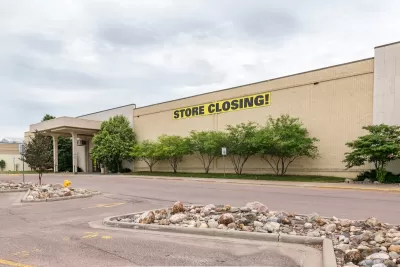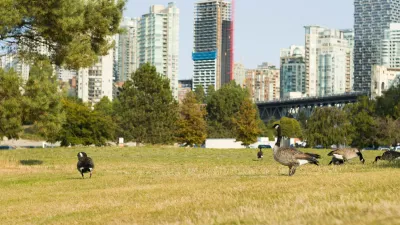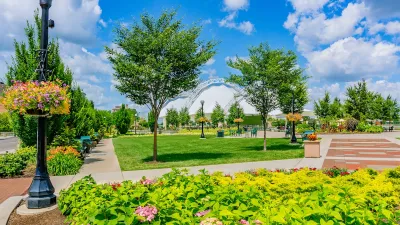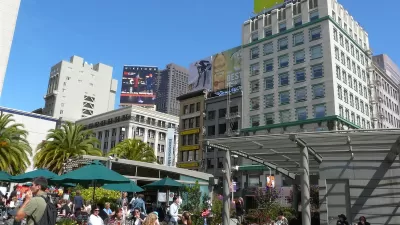Maybe zombie malls still have a second life — one with a little greenery.

Malls, once a bustling hub of commerce and Cinnabons, are now a shadow of their former selves. Over the last two decades, over a fifth of U.S. malls were shuttered, while another 25 percent are estimated to close by 2025. Exploring dead malls has even become a popular spectator sport on YouTube.
Yet, this retail demise comes with a cost — fueling job losses, negatively impacting local businesses, and reducing cities’ tax base. However, once we accept the passing of the mall era, this abundance of underutilized space represents a golden opportunity for redevelopment. Municipalities across the United States and beyond are rising to the retail occasion and converting these empty stores into other uses like theaters, gyms, or even housing.
Other communities are taking a different tack altogether: urban greening. By converting empty malls into green space, U.S. cities can supplement the scarce amount of green space, which covers only around 12 percent of the average urban landscape.
There are additional benefits beyond simply reclaiming derelict spaces: Filling cities with nature benefits people and the environment alike, while converting malls to parks retains their important role in communities as third spaces.
The rise and fall of the American mall
The retail landscape has changed drastically in the U.S. since the mid-1900s. Shopping malls got their start in the 1950s after waves of families moved from rural or downtown areas to newly formed suburbs, explains Mark Cohen, a former director of retail studies at Columbia University.
“It was a place not only for them to shop; it was a place for them to seek employment,” Cohen says. “So the Great American shopping center emerged and it was brilliantly successful because prior to its arrival, on the retail sea, folks either had to shop by a catalog or they had a shop downtown.”
In the decades that followed, that boom slowed. Mall productivity declined, and the 2008 recession struck another blow. Many of the larger anchor stores that populated malls, which attracted the bulk of customers, left at that time. This, in turn, fueled a decline in smaller specialty stores.
The final nail in the coffin was online shopping.
“A customer, pre-Amazon, pre-ecommerce, would pretty much have to shop at a mall within seven miles of where they lived…” Cohen says. “So they're stuck, they're handcuffed. But then along comes Amazon and it creates this phenomenon we all know to be ecommerce. And now suddenly the customer is given a handcuff key, removes the handcuffs, and is free to shop anywhere they want. They can browse. They can shop literally anywhere in the world.”
American e-commerce sales were worth a whopping $1.1 trillion in 2023, versus just over $136 billion in 2007. Already making up 22 percent of all retail sales, these figures are predicted to climb in the coming years.
Consequently, while some malls will continue to prosper as large regional shopping centers, many of the remaining 1,150 malls are likely to close.
Reenvisioning the mall
With all that yawning space, some municipalities are converting empty stores into other uses like arcades, office space, libraries, medical offices, schools, or car dealerships. This type of conversion brings its own set of challenges.
“For the most part, these things [malls] were never built with any kind of redevelopment in mind from a design and construction point of view,” Cohen says. “And so the cost of converting them into something else is something else…” He says most of the redevelopment schemes he knows of have failed because the developers either weren’t able to afford to do enough to make the space attractive or were unable to come up with a critical mass of activity that forms a new bull’s-eye for the customer.
So if redevelopment isn’t a viable approach, what are municipalities to do? Some have decided to bulldoze their malls and do something else with the land entirely.
For instance, some cities have swapped out a sizeable chunk of a mall’s footprint for much-needed green space that can help meet a variety of community needs and replace the proverbial parking lot with plants and trees.
Take Columbus, Ohio, where, in 2011, an abandoned mall downtown was transformed into a 6-acre park ringed by a mixed-use development. Two years prior, city leaders decided the nearly-empty building was unfit for renovation, since the costs would exceed those of simply tearing it down. While converting the building into something else — like indoor ski slopes, hotels, or casinos — was considered, ultimately, the city decided to move in a more natural direction. Spearheaded by the nonprofit Downtown Columbus, the greenspace project managed to recycle 80 percent of the materials from the former mall while also keeping the structure’s underground parking lot.
Now, surrounded by apartments, condos, and office buildings, this area has revitalized the previously crime-ridden area. Since the park’s opening, $400 million of new investment has gone into apartments, office buildings, and new retail stores in the area.
“I mean, none of those, the new housing surrounding that park, no one would have built it facing a windowless three-story box,” said Ellen Dunham-Jones, a professor and Director of the Master in Science in Urban Design at the Georgia Institute of Technology. In addition, the park serves as a place to draw both downtown residents and visitors to the city. It’s frequently abuzz with activity including concerts, fitness classes, races, and movie nights.
Besides placing a park front and center, another option for urban greening is building a mixed-use town center combining residential and commercial spaces, offices, hotels, and institutional and entertainment uses.
While these centers require a strong market to succeed, they bring a number of benefits, explained Dunham-Jones. For instance, residents of these compact living areas drive less, use less energy, and walk and bike more. Plus, these town centers often contain an outdoor gathering space such as a park.
A prime example is in Seattle, where an architectural firm transformed a former mall parking lot into a development with LEED-certified apartments, a medical center, retail space, and a park. Further, the park cleans water draining into a local creek — one critical for wildlife and spawning salmon.
Green space for everyone
These urban planning efforts matter since filling cities with greenery has an abundance of perks. Having access to parks and green spaces encourages exercise, reduces stress, and lowers cardiovascular and respiratory disease risk. It also improves our mood and attention while providing opportunities for social interactions. Further, green spaces fight the urban heat island effect. Elevated temperatures increase our energy demands, fueling greenhouse gas emissions and pollution. In addition, a hot urban environment can exacerbate heat waves, putting people at risk of illness and even death.
Besides the benefits for us, urban greening is great for the environment. Notably, green spaces provide habitat for wildlife including mammals, birds, turtles, fish, pollinating insects, and other animals, especially if these areas have native vegetation. In addition, parks with trees fight climate change by sequestering and storing carbon, as does soil.
Flooding the retail space
Besides adding more housing, greenery, and community space, mall redevelopment can present an opportunity to build much-needed infrastructure.
Take, for example, Meriden Mall in downtown Meriden, Connecticut, which was built on top of a creek in 1971. Flooding in the 1990s damaged the city’s downtown and caused $30 million in damages, fueling the mall’s demise. In 2005, the city took possession of the mall, now deemed a brownfield site. Years of laborious planning, approvals, and funding followed, including $2.9 million in federal and state funds matched by local sources and nearly $14 million in state and local bonds. However, by 2016, the community had replaced the empty shopping center with a 14-acre park and restored the creek along the way.
During sunny weather, the park functions as a green space in the middle of downtown explained Dunham-Jones. However, when the remnants of Hurricane Irene dumped rain across the city, the park filled up as it was designed to do. Known as a stormwater park, this new green space pulled 227 downtown properties out of the floodplain. In fact, the park, complete with flood-control ponds, can hold 60 acre-feet of water or nearly 30 Olympic-sized swimming pools. It also has pedestrian bridges, walking paths, and a 2,150-square-foot amphitheater.
This security from flooding has revitalized development in the downtown, said Dunham-Jones. This included renovating the train station and adding mixed-use and residential buildings with affordable housing units. The city has seen very low vacancy rates in city apartments, and home prices increased to $300,000.
Likewise, a shopping center in St. Paul, Minnesota, was returned to its former state — a wetland. Initially part of the Mississippi watershed, it was paved over in 1960 to make way for the Phalen Shopping Center. However, a highway meant to fuel traffic to the mall was never built, and rival commercial centers eventually outcompeted the retail center.
By the late 1990s, under declining commercial and residential property values, the community was ready for change. Funded by the Legislative Commission on Minnesota Resources, the Ramsey-Washington Metro Watershed District, and the Metropolitan Council for the Twin Cities, the mall was destroyed — including 10 feet of blacktop in some places. Then, a coalition of local community groups, private and public partners and even school children restored the seven acres of wetland. The lake now provides wildlife habitat, cleans water, and prevents flooding in the area. Plus, the community uses the site for walks, bird-watching, fishing, and school trips.
Obstacles to urban greening
However, park creation has some challenges — for instance, funding. Even once funding is secured, another drawback arises.
“If it's a public space, there's typically no tax revenue to replace the substantial tax revenue that the mall provided the community in the first place,” said Cohen. Nonetheless, parks do have the ability to attract a larger tax base to a community. “Regreening done well can absolutely spawn redevelopment and it's such a good way to do that,” said Dunham-Jones.
Despite this, green space creation in urban areas can be hampered by a variety of other factors, such as traffic patterns, shading from buildings, and development pressures. Urban planners may also have to grapple with insufficient collaboration between municipal departments and stakeholders, a lack of knowledge of urban green spaces’ value, and a dearth of tools and policies for urban greening. Other hurdles include outdated zoning codes and difficulty getting buy-in from citizens.
The future of shopping
Over half the world’s population already lives in cities, and that number is predicted to increase. Transforming our urban areas into more sustainable spaces directly benefits people while also making room for nature. This is critical since over the past two decades, urban sprawl has crept over 14,000 square miles of undeveloped land in the U.S., fueling biodiversity loss.
Reclaiming unused properties for green space can fight sprawl, reclaim valuable square footage in dense urban areas, and change the fabric of our cities in ways that benefit residents, boost the economy, and help manage stormwater and reduce the urban heat island effect.
“The whole idea of a shopping mall has come and gone…” said Cohen. “It's a blight — what had been an absolute boom years ago for a community.”
That blight can still be transformed — especially with a little nature.

Maui's Vacation Rental Debate Turns Ugly
Verbal attacks, misinformation campaigns and fistfights plague a high-stakes debate to convert thousands of vacation rentals into long-term housing.

Planetizen Federal Action Tracker
A weekly monitor of how Trump’s orders and actions are impacting planners and planning in America.

In Urban Planning, AI Prompting Could be the New Design Thinking
Creativity has long been key to great urban design. What if we see AI as our new creative partner?

Portland Raises Parking Fees to Pay for Street Maintenance
The city is struggling to bridge a massive budget gap at the Bureau of Transportation, which largely depleted its reserves during the Civd-19 pandemic.

Spokane Mayor Introduces Housing Reforms Package
Mayor Lisa Brown’s proposals include deferring or waiving some development fees to encourage more affordable housing development.

Houston Mayor Kills Another Bike Lane
The mayor rejected a proposed bike lane in the Montrose district in keeping with his pledge to maintain car lanes.
Urban Design for Planners 1: Software Tools
This six-course series explores essential urban design concepts using open source software and equips planners with the tools they need to participate fully in the urban design process.
Planning for Universal Design
Learn the tools for implementing Universal Design in planning regulations.
Gallatin County Department of Planning & Community Development
Heyer Gruel & Associates PA
JM Goldson LLC
City of Camden Redevelopment Agency
City of Astoria
Transportation Research & Education Center (TREC) at Portland State University
Jefferson Parish Government
Camden Redevelopment Agency
City of Claremont





























